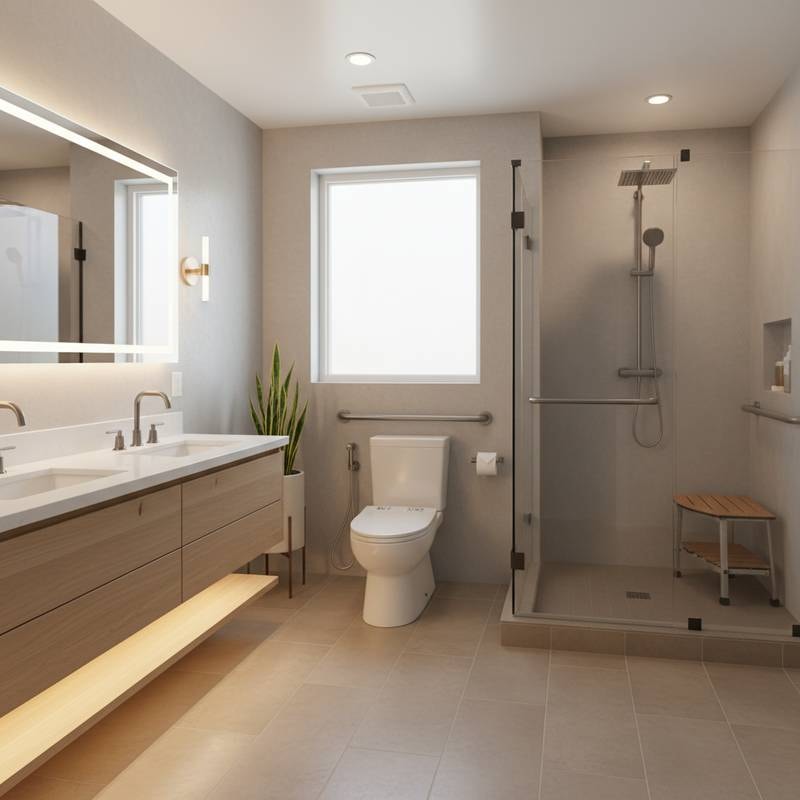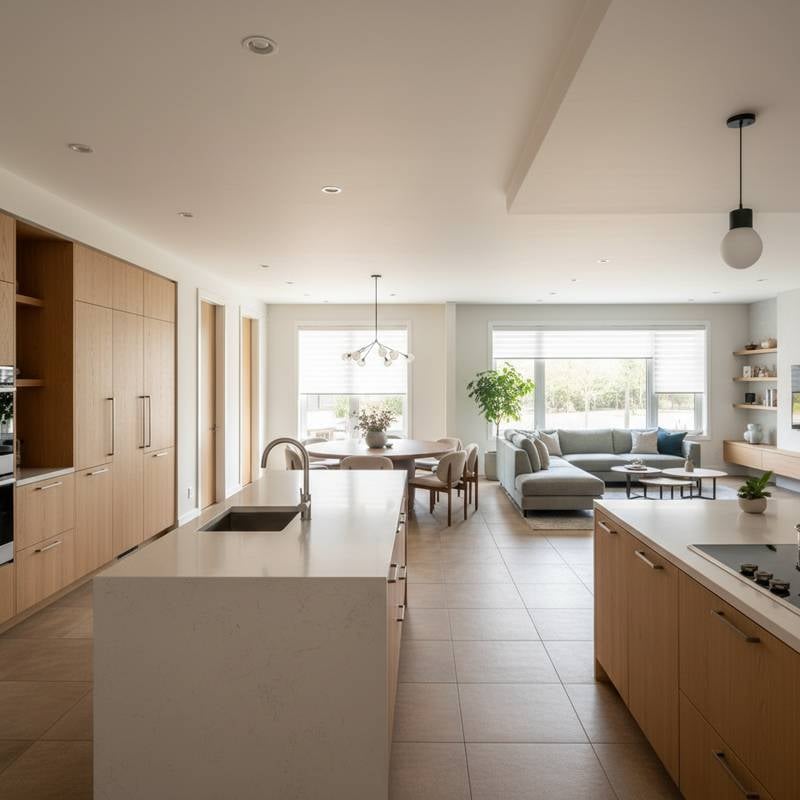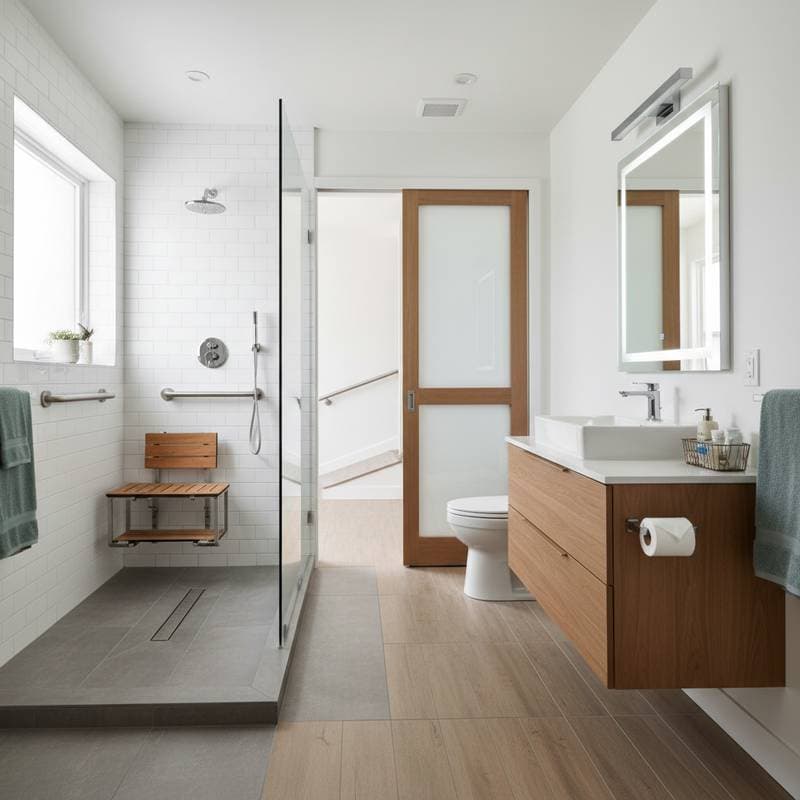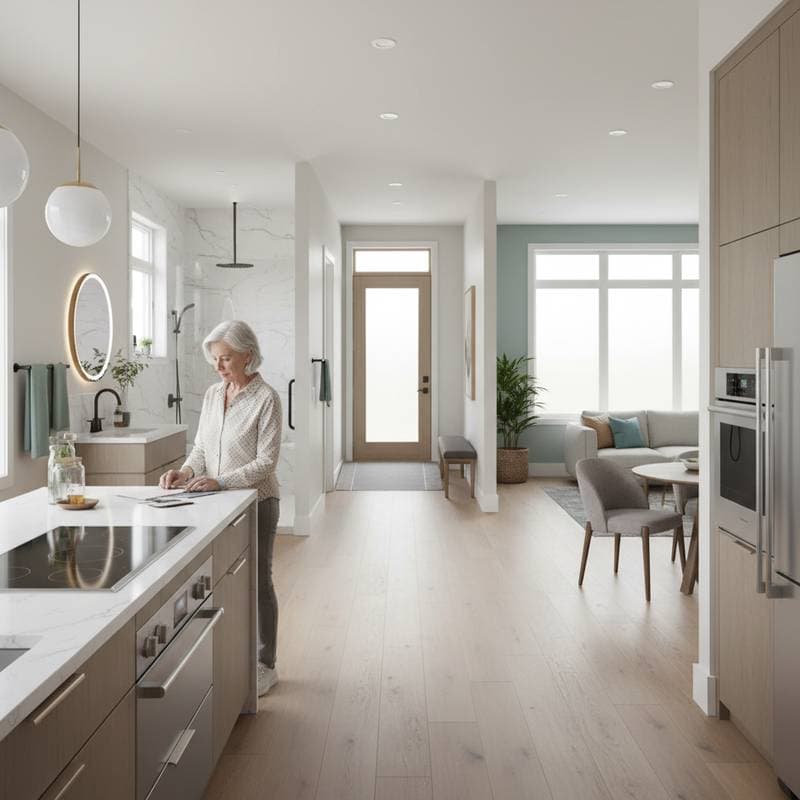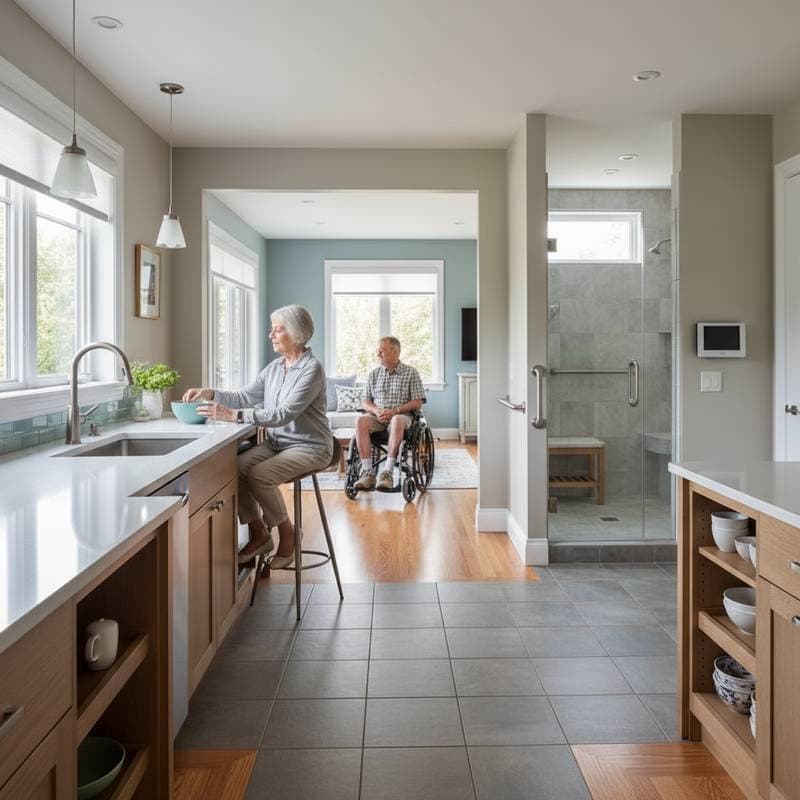Transform Your Bathroom for Safe Aging in Place
Quick Answer Box
Aging-in-place bathroom modifications enhance safety and comfort for seniors who prefer to remain in their homes. This project fits homeowners with moderate do-it-yourself abilities or those who engage a licensed contractor. Budget approximately $5,000 to $15,000 for comprehensive renovations or $500 to $2,000 for targeted safety enhancements. Allocate one day for simple adjustments or up to two weeks for a complete overhaul. Primary hazards involve slips, electrical issues, and plumbing failures, so utilize protective equipment and confirm proper shutoffs.
Step-by-Step Instructions
1. Assess Existing Safety and Accessibility
Conduct a thorough walkthrough of the bathroom to identify potential trip hazards, cramped areas, or fixtures that prove difficult to access.
- Evaluate the traction of the current floor surface.
- Measure the doorway width; a minimum clear opening of 32 inches accommodates most mobility aids.
- Pinpoint zones requiring enhanced illumination.
Verification: Compile a detailed inventory of concerns prior to acquiring any materials.
2. Improve Lighting and Visibility
Substitute outdated bulbs with high-lumen, energy-efficient LED options. Incorporate task lighting adjacent to mirrors and softer ambient sources for nighttime use.
- Select fixtures featuring diffused covers to minimize glare.
- Integrate motion-activated sensors or low-level nightlights to facilitate navigation in dim conditions.
Verification: Confirm uniform illumination throughout the space, free from stark shadows.
3. Install Grab Bars in Key Locations
Caution: Secure grab bars firmly to wall studs rather than relying solely on drywall anchors.
Employ a stud finder to detect studs positioned near the toilet, shower, and bathtub. Mount bars at a height of 33 to 36 inches from the floor level.
- For tiled areas, utilize a carbide-tipped drill bit to create pilot holes.
- Apply silicone caulk around anchor points to block moisture infiltration.
Verification: Test each bar to ensure it supports full body weight without shifting.
4. Replace Flooring with Slip-Resistant Material
Fall Hazard: Steer clear of slick tiles or polished stone surfaces. Opt for textured vinyl planks, matte porcelain tiles, or resilient rubber mats.
Pry up existing flooring with care to avoid subfloor damage. Smooth any uneven subfloor sections using a self-leveling compound.
- Spread thin-set mortar uniformly as the adhesive base.
- Maintain 1/8-inch grout joints between tiles to enhance grip.
Verification: The completed surface must feel stable, level, and subtly textured underfoot.
5. Swap Faucets for Lever Handles
Lever-style handles simplify operation compared to traditional twist knobs, particularly for individuals with reduced hand strength.
Plumbing Hazard: Isolate the water supply lines before detaching existing components.
Disconnect supply lines with an adjustable wrench, then attach the new lever faucet using included washers and sealing gaskets.
Verification: Confirm steady water flow and complete shutoff without drips or seepage.
6. Upgrade to a Comfort-Height Toilet
Elevated toilet seats alleviate physical strain during sitting and rising motions.
- Determine the rough-in measurement from the drain center to the rear wall prior to selection.
- Anchor the replacement unit to the floor flange with a fresh wax ring and fastening bolts.
Verification: Ensure the toilet base remains plumb and free from wobbling.
7. Improve Shower Accessibility
Transition to a curbless or low-threshold design for seamless entry. Engage a licensed contractor for adjustments involving drain gradients or waterproof membranes.
Incorporate a handheld showerhead mounted on an adjustable sliding rail to permit personalized height settings.
Position a fixed or collapsible bench within the enclosure to provide resting support.
Verification: Observe complete drainage without standing water, and verify that controls fall within comfortable reach.
8. Add Storage at Reachable Heights
Eliminate high cabinets that demand excessive reaching. Install lower shelving units, extendable drawers, or recessed wall pockets instead.
Verification: All frequently used essentials remain accessible without excessive bending or overhead extension.
Quality Checks and Troubleshooting
Common Issues and Fixes:
- Loose grab bar: Reinforce anchoring into studs or substitute with heavy-duty wall reinforcements rated for substantial loads.
- Water leak at faucet: Secure all fittings and substitute deteriorated gaskets or seals.
- Uneven lighting: Reposition fixture mounts or introduce supplementary light sources for balance.
- Water pooling in shower: Clear debris from the drain and validate a minimum slope of 1/4 inch per linear foot.
Success Indicators:
- Fixtures function without resistance.
- Absence of leaks or moisture marks following a 24-hour test period.
- Unobstructed, comfortable navigation throughout the area.
When to Call a Professional
Engage a licensed plumber for tasks such as:
- Relocating drains or water supply pipes.
- Fabricating a curbless shower base.
- Accessing or replacing concealed valves.
Engage a licensed electrician for tasks such as:
- Extending electrical circuits or installing ground-fault circuit interrupter outlets.
- Permanently wiring illumination fixtures.
Engage a general contractor for tasks such as:
- Expanding doorway dimensions.
- Reconstructing subfloor structures.
- Converting bathtubs to barrier-free showers.
Typical Costs:
- Grab bars and related hardware: $150 to $400 including installation.
- Slip-resistant flooring: $5 to $10 per square foot.
- Comfort-height toilet: $300 to $800 including installation.
- Comprehensive remodel involving structural alterations: $10,000 to $15,000 or higher.
Evaluate potential contractors through verification of credentials, insurance coverage, and client testimonials. Request itemized proposals and comprehensive project outlines in writing.
Pro Tips for Success
- Select color schemes with high contrast between floors, walls, and fixtures to aid visual orientation.
- Maintain clear pathways of at least 36 inches to support walkers or wheelchairs.
- Incorporate rounded contours on counter edges to reduce impact risks.
- Prefer a flexible shower curtain over a fixed glass enclosure for simplified entry.
- Position towel racks at accessible levels, but designate them solely for drying purposes, not support.
Sustaining Long-Term Accessibility
A thoughtfully modified bathroom fosters autonomy and reassurance in daily routines. Conduct periodic evaluations and minor refinements to avert major expenses down the line. Preserve dry conditions on surfaces, sustain adequate brightness, and reinforce fixture integrity. As physical capabilities evolve, revisit the design to incorporate necessary adaptations. Thoughtful preparation combined with diligent maintenance guarantees enduring functionality, ease, and suitability for extended home residency.

